GODZILLA (2014) Review [Spoiler Free]
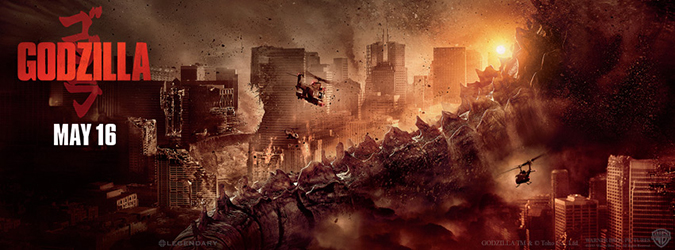
Godzilla by Legendary Pictures
Directed by Gareth Edwards
Review by Kyle Yount
The King of the Monsters has returned to the shores of America in a brand new film from Legendary Pictures (THE DARK KNIGHT, WATCHMEN, CLASH OF THE TITANS) and it’s about damned time! Since the licensing agreement was announced in 2010, kaiju fans around the world have been anxiously awaiting this week, hoping that this new installment will live up to the sixty-year legacy established by Toho Co, Ltd. This review is written explicitly for Godzilla enthusiasts like myself, commenting on the quality of the film and comparing it to the Japanese series without spoilers.

A scene from Warner Bros. Pictures’ and Legendary Pictures’ epic action adventure “GODZILLA,” a Warner Bros. Pictures release.
(Courtesy of Warner Bros. Pictures © 2014 WARNER BROS. ENTERTAINMENT INC. & LEGENDARY PICTURES PRODUCTIONS LLC)
Gareth Edwards, whose only theatrical credit was the 2010 independent film MONSTERS, was tapped by Legendary Pictures to direct GODZILLA thanks to his indie success, bringing his tale to life with a minimal budget ($500,000 USD) and crew. Clearly an impressive feat from a visual standpoint, but while watching Monsters, I never felt connected to the two main characters, much less did I like them as humans. This is relevant as it will come into play a little later when discussing the character development in Godzilla. Gareth Edwards worked with Max Borenstein turning a basic story by David Callaham into this move’s screenplay. As we have reported on the podcast before, Godzilla’s script was massaged by a myriad of screenwriters including David Goyer and Frank Darabont, but Borenstein retains the screenplay credit. Initially, I was concerned for the script, thinking Hollywood might be setting up a “too many cooks” scenario. Thankfully a solid and completely serviceable shooting script was turned in. Bryan Cranston, Aaron Taylor Johnson and Elizabeth Olsen headline the film’s cast with Ken Watanabe, Juliette Binoche, Sally Hawkins and David Strathairn fleshing out the supporting characters.
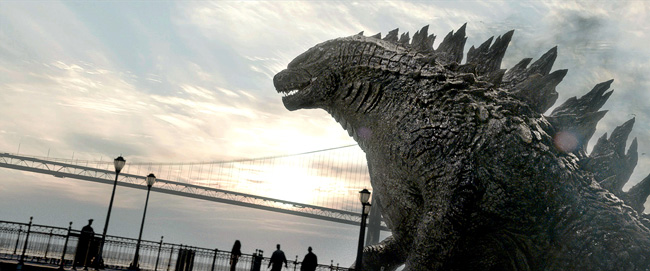
Courtesy of Warner Bros. Pictures © 2014 WARNER BROS. ENTERTAINMENT INC. & LEGENDARY PICTURES PRODUCTIONS LLC
Without getting into the detailed character development, I felt that Cranston, Binoche, Watanabe and Hawkins are the true human stars of Godzilla – and I was quite pleased that Watanabe was utilized often with a well defined nod to the original Godzilla film. Aaron Taylor Johnson and Elizabeth Olsen do a fine job as the romantic couple, but I never connected with their characters, Ford and Elle Brody. What should have been significant moments in their relationship never struck me on an emotional level. As a giant monster enthusiast, I often hear the classic dismissal “Who cares about the human drama?? Godzilla movies are all about the monsters!” I will admit that the monsters are the real draw for the fans, but the human element is what propels the story and/or weaves through the kaiju battles and destruction. Think of some of the most popular Godzilla films – the human protagonists are just as important as the creatures themselves. In fact, I would say that the human element is what generally controls the ranking of a Godzilla film. In that respect, Edwards’ romantic leads lack that dramatic weight to really connect with the audience. That emotional bond is fairly weak, but I want to emphasize that Johnson and Olsen are NOT annoying like Matthew Broderick and Maria Pitillo were in Tri-Star’s 1998 attempt.
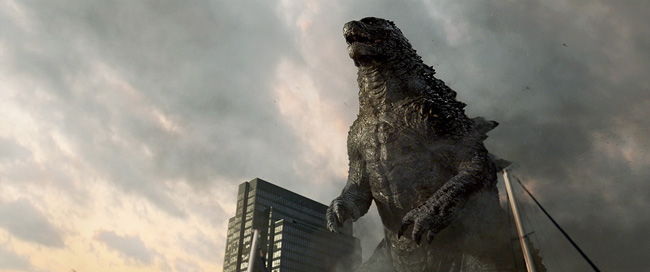
Courtesy of Warner Bros. Pictures © 2014 WARNER BROS. ENTERTAINMENT INC. & LEGENDARY PICTURES PRODUCTIONS LLC
We don’t need to cover the flaws of that film, but how does Legendary’s kaiju king stack up against the both Japanese characterization and the previous American incarnation? Listeners to the podcast know that my biggest problem with the Tri-Star Film was that their monster didn’t act (or look) like our Godzilla. Our Godzilla doesn’t hide or run away from the military. Our Godzilla brushes off attacks and if a building or bridge gets in the way, consider it rubble. Gareth Edwards was pretty clear from the beginning, this Godzilla is going back to the “force of nature” roots of the character. And let me assure you, Godzilla is a character in this film. He may not get as much screen time as the humans, but he isn’t simply an animal – he is a massive beast of destruction. This Godzilla is designed to fight monsters, topple buildings and, surprisingly, show the audience some personality. I was somewhat shocked when Godzilla recovered from a particularly strong blow and reacted with a slight shake of the head and roll of the eyes – clearing away the cobwebs. Don’t expect the “Shie Dance” after a victory, but you can get a great sense for what the titular titan is thinking. Because I am trying to avoid revealing any detailed information about the film, I will simply say that I was quite pleased with Godzilla’s on screen appearances.
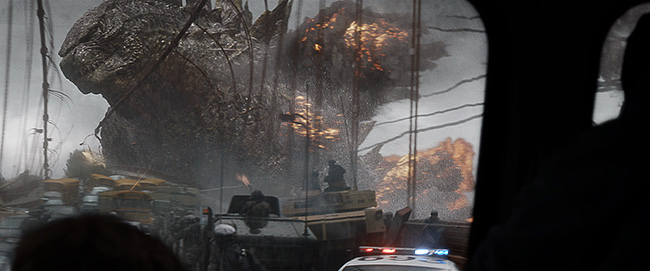
Courtesy of Warner Bros. Pictures © 2014 WARNER BROS. ENTERTAINMENT INC. & LEGENDARY PICTURES PRODUCTIONS LLC
In today’s digital age, I don’t think it would surprise anyone to learn that Godzilla’s visual effects are heavily reliant on computer graphics. Without a doubt the strongest aspect of this film, the effects work is phenomenal. In my singular viewing of the movie, the blend of real-world sets and CGI was pretty flawless – I can’t recall a single effect or shot that looked unbelievable. True, I prefer the man-in-suit treatment, but I understand that technique would never win over today’s moviegoers. Just like most of Hollywood’s big budget scifi flicks, the effects in Godzilla are on par. Perhaps another viewing of the film will “level up” my evaluation of the effects and Godzilla will tower over the competition.
In conclusion, Godzilla is difficult to grade. If you compare it to the Japanese series, this new feature doesn’t work alongside its Asian counterparts, but it’s a good movie. The differences between the Japanese entries and this new release are simply too divergent – apples and oranges. And it has nothing to do with the technological superiority of the Hollywood effects engine. Trying to place Legendary’s movie into the Toho series won’t work, but the film itself does work on it’s own – as a singular entry. It may not be fair to compare this to Dean Devlin and Roland Emmerich’s film, but I feel that this needs to be covered. Legendary Pictures’ new Godzilla blows the Tri-Star version out of the water, into the atmosphere and straight into the sun, where it should die a quick but definite death. The filmmakers behind the 1998 film have admitted not having respect for the original films while both Legendary Pictures and Gareth Edwards have been incredibly respectful of the source material. Perhaps because of that, their Godzilla definitely deserves your dollars!
Earlier this year, I went on record recently saying, “I’ll be happy if the movie doesn’t suck.” Guess what… I’m happy.
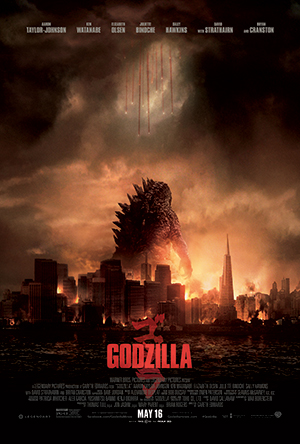
One sheet poster design for Legendary’s new GODZILLA. © 2014 WARNER BROS. ENTERTAINMENT INC. & LEGENDARY PICTURES PRODUCTIONS LLC
Afterthoughts:
There are a few of points that I would like to address on an official response kind of level – these are not concerns that I have heard from listeners but comments I’ve seen on other social media sites; complaints levied against the film before it was even screened. The first of which is “Whitewashing”, a term for Hollywood’s casting of predominantly white actors in lieu of ethnic role definitions. This term has been bandied about since the very first teaser was released and to be honest, it is a buzzword and a premature criticism. There are loads of Japanese actors in the scenes from Japan, but after leaving the land of the rising sun, this film predominantly takes places in the United States and yet still retains a more-than-white cast. If you hear this criticism lobbied at Godzilla, ignore it; we already have twenty-eight Godzilla films set in Japan featuring some of Japan’s top actors.
The second buzzword is a term that I had never really heard until recently. People online are calling Godzilla “Disaster Porn” – this is a term originally penned to comment on the new media’s continual coverage of disasters. It has since been applied to Hollywoods output of films like Pompeii, World War Z, The Day After Tomorrow and, now, Godzilla. There’s really nothing new about this film trend, we’ve been watching films like Towering Inferno, The Poseidon Adventure and Earthquake since film studios were able to use special effects. I hate the use of this term, but I have to admit Godzilla is and always has had a hand in this genre (some films more than others, obviously). Hey, disaster porn… who’s your daddy? Yup, it’s Godzilla.
One of the most prominent complaint I’m seeing is that “Japanese fans are saying that the American Godzilla is too fat” (it’s been a sensational headline in my news feed for the past few weeks). First, that claim is ludicrous. Look at the Japanese Godzilla suits from 1962 or 1994 or even 2001. I cannot tell you how many times I’ve heard them referred to as “thunder thigh-zilla” or that Godzilla looks like a sumo wrestler. The fact is that a few fans’ negative comments (found online) were culled from a lot of other comments, one of which was the fat-shaming of this new version. Sometimes I just want to slap the internet…. this is one of those times.
 Follow
Follow







